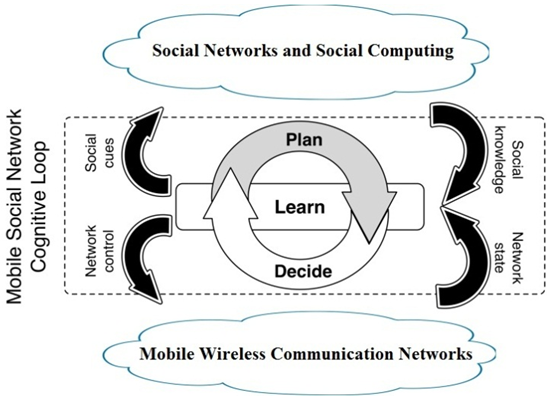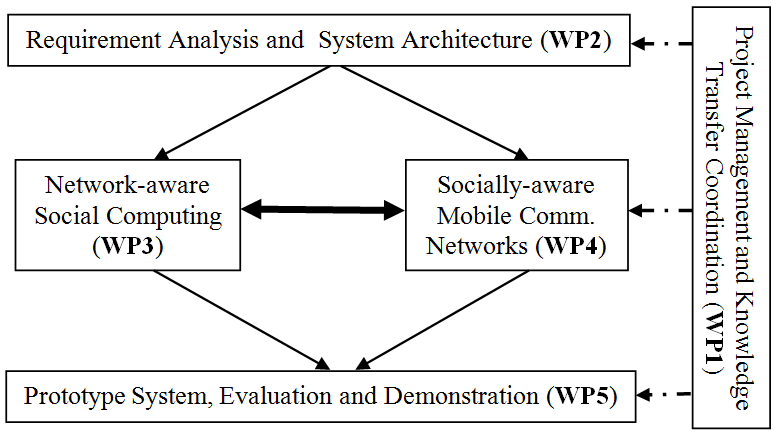



Full Title: Cross-Layer Investigation and Integration of Computing and Networking Aspects of Mobile Social Networks
Acronym: CLIMBER
Grant Agreement Number: PIRSES-GA-2012-318939
Duration of the project: 48 months (01 April. 2013 - 31 Mar. 2017)
This project advocates a brand-new angle of researching into the emerging frontier field of mobile social networks (MSNs). This new angle exhibits two inherent aspects of its nature: its physical aspect as embodied by a cluster of mobile devices for data transmission through wireless radio channels; and its virtual and social aspect as symbolized by an overlay software platform that enables mobile users to communicate among themselves and/or to the outside Internet. The former represents a mobile wireless communication network whereas the latter is a social network. Most importantly, the CLIMBER project proposes cross-layer design and integration of these two types of networks in order to achieve an optimal operation of the overall MSNs.
This new angle of researching into MSNs calls for new approaches that shall involve not only cross-layer design (e.g., social knowledge at the higher application layer and communication protocols at the lower data transmission layer) but also inter-disciplinarity (e.g., social computing on one hand and network engineering on the other hand). The CLIMBER project aims to making some first-time exploration into this exciting and challenging field by investigating into how social computing and network operational process communicate with each other for their mutual benefits. The exchange of cross-layer information enables to advise each layer to design more effective and efficient operational procedure and algorithms. This is expected to create a new vision of MSNs that can be tailored to benefit network providers, content providers and end users.
The information of communication networks to be exchanged includes those from either mobile devices such as the location of a mobile phone and its available air interfaces (3G, or WiFi, or WiMAX, or LTE, etc) and thus the features of these physical interfaces (e.g., bandwidth capacity, cost, etc) or the key performance indicator of wireless access networks (e.g., delay, degree of congestion, availability of a base station, etc). On the one hand, the purpose of this project is to design a better mobile social network that is mobile network-aware with the ability of working in a distributed manner to cater for infrastructure-less network topology. This constitutes the tasks of work-package (WP) 3: Mobile Network-aware Social Computing. On the other hand, social information (e.g., clusters and communities) also needs to be exposed to communication networks, namely, socially-aware mobile networks, so as to enhance the capability of communications among mobile users in terms of speed, efficiency, privacy, etc. Therefore, WP4: Socially-aware Mobile Wireless Communication Networks is dedicated to fulfilling this goal.
Taken together, these two interactive aspects (Network-aware Social Computing and Socially-aware Mobile Wireless Communication Networks) create a so-called cognitive loop, as illustrated in Figure 1, which means that the networks become self-aware of themselves and surroundings and, accordingly, are able to learn, decide and act based on particular high-level goals. Well-known cognition techniques (e.g., learning machines and game theory) can be used to control this loop. In conventional cognitive loops, such as in cognitive radio networks (CRNs), the operating domain of the loop is in a single contextual environment, e.g., the electromagnetic spectrum. This means that only a single set of sensing parameters and actuators are necessary. In CLIMBER, we envisage the creation of a dual-domain cognitive system wherein a learning system incorporates sensing (measuring) information from both a social user context as well as the communication network state experienced by the user device. This information is fed into the learning system that processes it, providing as output changes in the network control parameters and indicators or cues for social interaction.
As far as the used wireless technology is concerned, the majority of the existing research works on MSNs either does not really concern the underlying transmission networks or simply assumes 3G or WiFi networks. This proposed project intends to take into account a co-existence of heterogeneous wireless networks (e.g., WiFi and WiMAX) in an MSN environment. In addition, wireless networks, such as 3G (European’s UMTS: Universal Mobile Telecommunications System) and 3.5G (HSPA – High Speed Packet Access) can also be accommodated in such an MSN to reflect the reality of the current network coverage. The adoption of a heterogeneous wireless network is also to make best use of the rich network ability of modern smart phones, which are increasingly equipped with multiple air interfaces such as 3G, GPS, Bluetooth, WiFi, WiMAX and even LTE. A real-life MSN should be designed as close to reality as possible. Note that it is not this project’s intention to research into all these areas from scratch. Instead of reinventing the wheel, the CLIMBER project is to build upon each partner’s complementary expertise and the outcomes of the relevant interlinked projects that the partners are involved in.

Figure 1: Two Dimensions of Management of Mobile Social Networks
The implementation and management of this project is to be achieved through three types of activities operating in parallel during the whole duration of the project: Management Activities, Research Activities and Knowledge Transfer Activities. WP1 is dedicated to project management for the coordination of both research activities and knowledge transfer activities. The purpose of research activities is to fulfil the scientific objective of the project, i.e., to research into infrastructure, algorithms and services of the new vision of MSNs. These activities are divided into four technical WPs: WP2-WP5. The works-package structure is shown in Figure 2.

Figure 2: Work-package Structure